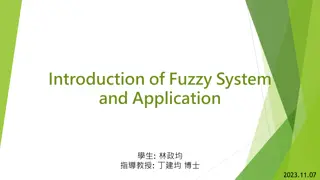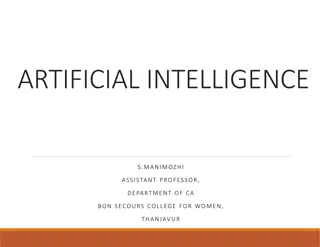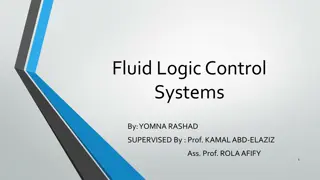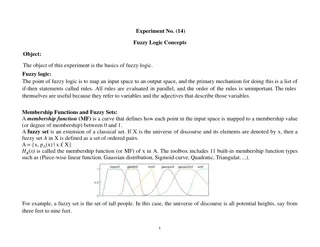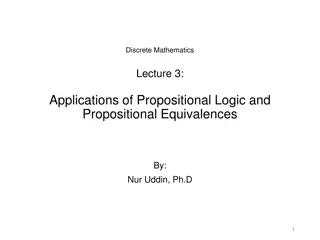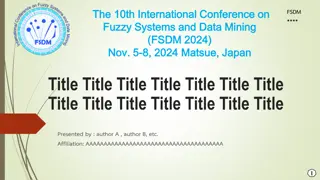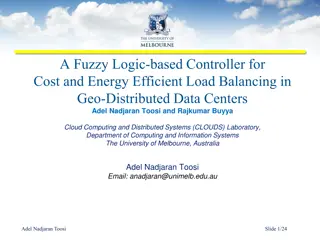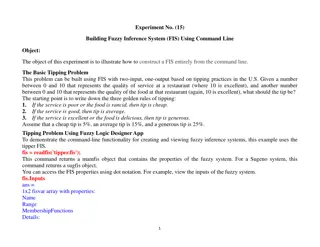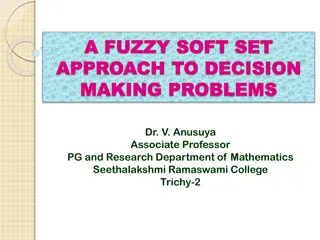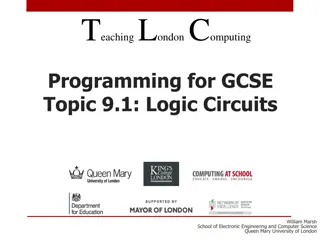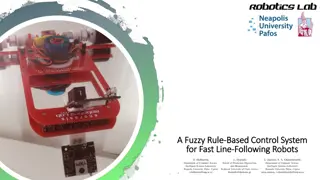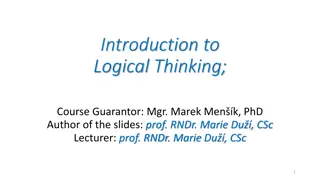Understanding Fuzzy Logic: Basics and Applications
Fuzzy logic deals with imprecise or ambiguous information, providing a way to represent and process data that is not clearly defined as true or false. This concept was introduced by Lofti A. Zadeh in 1965 through his research on Fuzzy Sets. Fuzzy logic allows for degrees of truth and provides a method for handling uncertain or vague decision-making processes. Contrasting fuzzy sets with crisp sets, it becomes clear that fuzzy systems accommodate partial membership, while crisp sets have well-defined boundaries. Applications of fuzzy logic can be found in fields such as decision making, control systems, and more.
Uploaded on Oct 09, 2024 | 0 Views
Download Presentation

Please find below an Image/Link to download the presentation.
The content on the website is provided AS IS for your information and personal use only. It may not be sold, licensed, or shared on other websites without obtaining consent from the author. Download presentation by click this link. If you encounter any issues during the download, it is possible that the publisher has removed the file from their server.
E N D
Presentation Transcript
UNIT 2 Course Guidelines Fuzzy Logic: Fuzzy rule base system: Fuzzy propositions, fuzzy rules, fuzzy Fuzzy set versus crisp set, reasoning, basic concepts of fuzzy sets, Fuzzy Inference Systems (FIS) membership functions, Fuzzification & Defuzzification, basic operations on fuzzy sets Fuzzy decision making. and its properties. Applications of fuzzy logic. Fuzzy relations versus Crisp relation.
What is Fuzzy Logic? The word fuzzy refers to things which are not clear or are vague. Any event, process, or function that is changing continuously cannot always be defined as either true or false, which means that we need to define such activities in a Fuzzy manner. Fuzzy methodology. information. This is gross oversimplification of the real- world problems and based on degrees of truth rather than usual true/false or 1/0 like Boolean logic. Logic resembles It deals the with human vague decision-making and imprecise
. Fuzzy Logic Example Take a look at the following diagram. It shows that in fuzzy systems, the values are indicated by a number in the range from 0 to 1. Here 1.0 represents absolute truth and 0.0 represents absolute falseness. The number which indicates the value in fuzzy systems is called the truth value.
Example Cont. In other words, we can say that fuzzy logic is not logic that is fuzzy, but logic that is used to describe fuzziness. There can be numerous other examples like this with the help of which we can understand the concept of fuzzy logic. Fuzzy Logic was introduced in 1965 by Lofti A. Zadeh in his research paper Fuzzy Sets . He is considered as the father of Fuzzy Logic.
Fuzzy Set & Crisp Set BASIS FOR FUZZY SET CRISP SET COMPARISON Prescribed by vague or Defined by precise and Basic ambiguous properties. certain characteristics. Elements are allowed to Element is either the Property be partially included in the member of a set or not. set. Used in fuzzy controllers Digital design Applications Infinite-valued bi-valued Logic
Key Differences Between Fuzzy Set and Crisp Set A fuzzy set is determined by its indeterminate boundaries, there exists an uncertainty about the set boundaries. On the other hand, a crisp set is defined by crisp boundaries, and contain the precise location of the set boundaries. Fuzzy set elements are permitted to be partly accommodated by the set (exhibiting gradual membership degrees). Conversely, crisp set elements can have a total membership or non-membership. There are several applications of the crisp and fuzzy set theory, but both are driven towards the development of the efficient expert systems. The fuzzy set follows the infinite-valued logic whereas a crisp set is based on bi-valued logic.
Fuzzy Logic - Membership Function We already know that fuzzy logic is not logic that is fuzzy but logic that is used to describe fuzziness. This fuzziness is best characterized by its membership function. In other words, we can say that membership function represents the degree of truth in fuzzy logic.
More about MF Membership functions were first introduced in 1965 by Lofti A. Zadeh in his first research paper fuzzy sets . Membership functions characterize fuzziness (i.e., all the information in fuzzy set), whether the elements in fuzzy sets are discrete or continuous. Membership functions can be defined as a technique to solve practical problems by experience rather than knowledge. Membership functions are represented by graphical forms. Rules for defining fuzziness are fuzzy too.
Features of Membership Functions 1. Core For any fuzzy set A A~, the core of a membership function is that region of universe that is characterize by full membership in the set. Hence, core consists of all those elements yy of the universe of information such that, A (y)=1 Support For any fuzzy set A A~, the support of a membership function is the region of universe that is characterize by a nonzero membership in the set. Hence core consists of all those elements yy of the universe of information such that, A (y)>0 3. Boundary For any fuzzy set A A~, the boundary of a membership function is the region of universe that is characterized by a nonzero but incomplete membership in the set. Hence, core consists of all those elements yy of the universe of information such that, 2. 1> A (y)>0
Fuzzy Logic - Classical Set Theory Can be found and read PDF at my blog or reference the book as per given below: Discrete Mathematics (Schaum's Outlines) (SIE) Paperback 1 Jul 2017 by Seymour Lipschutz (Author), Marc Laras Lipson (Author), Varsha H. Patil (Author)
Fuzzy Set Fuzzy sets can be considered as an extension and gross oversimplification of classical sets. It can be best understood in the context of set membership. Basically it allows partial membership which means that it contain elements that have varying degrees of membership in the set. From this, we can understand the difference between classical set and fuzzy set. Classical set contains elements that satisfy precise properties of membership while fuzzy set contains elements that satisfy imprecise properties of membership.
Mathematical Concept A fuzzy set A A~ in the universe of information UU can be defined as a set of ordered pairs and it can be represented mathematically as A ={(y, A (y))|y U} (Here A (y) = degree of membership of yy in \widetilde{A}, assumes values in the range from 0 to 1, i.e., A (y) [0,1])
Representation of fuzzy set Let us now consider two cases of universe of information and understand how a fuzzy set can be represented. In the above representation, the summation symbol represents the element. collection of each
Operations on Fuzzy Sets Having two fuzzy sets A and B , the universe of information UU and an element ? of the universe, the following relations express the union, intersection and complement operation on fuzzy sets. Union/Fuzzy OR Let us consider the following representation to understand how the Union/Fuzzy OR relation works A B (y)= A B y U Here represents the max operation.
Intersection/Fuzzy AND Let us consider the following representation to understand how the Intersection/Fuzzy AND relation works A B (y)= A B y U Here represents the min operation.
Complement/Fuzzy NOT Let understand how the Complement/Fuzzy NOT relation works A =1 A (y) y U us consider the following representation to Let us consider the following repres
Properties of Fuzzy Sets Let us discuss the different properties of fuzzy sets. Commutative Property Having two fuzzy sets A and B , this property states A B =B A A B =B A
Associative Property Having three fuzzy sets A A~, B B~ and C C~, this property states A (B C )=(A B ) C A (B C )=(A B ) C A
Distributive Property Having three fuzzy sets A , B and C , this property states A (B C )=(A B ) (A C ) A (B C )=(A B ) (A C ) Idempotency Property For any fuzzy set A A~, this property states A A =A A A =A
Identity Property For fuzzy set A and universal set U, this property states A =A A U=A A = A U=U Transitive Property Having three fuzzy sets A , B and C , this property states If A B C ,thenA C Involution Property For any fuzzy set A , this property states
De Morgans Law This law plays a crucial role in proving tautologies and contradiction. This law states
References for this Course S.N. Sivanandam & S.N. Deepa, Principles of Soft Computing , 2nd Edn., Wiley Publications, 2008. PPT & Notes from link provided
You can download this PPT and Syllabus from below Link: https://sureshkaswan.wordpress.com/ or contact me via Email/Phone: sureshkaswan@rimt.ac.in +91-7876444448 Thank You


